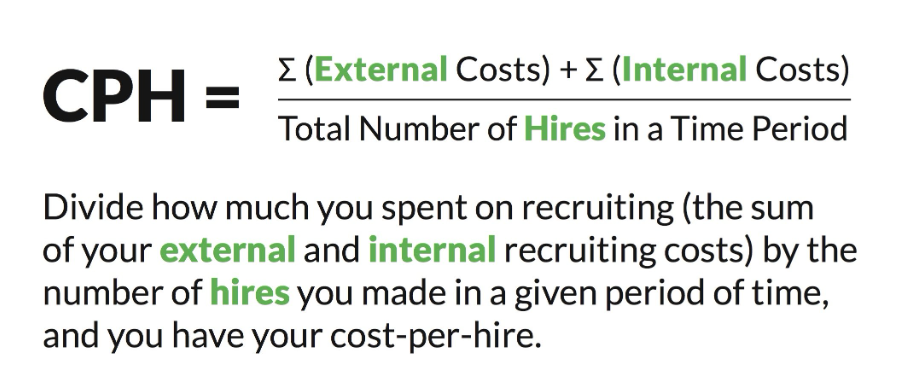Major cities cost per hire. Second Ep.
Hiring a new employee is a great investment for the company everyone understands that quality most of the time matters more than quantity, and the quality in a talent pool is not easy to find. It requires handpicking one out of hundreds, sometimes even thousands to hire an employee or employees, there is even a whole study called “talent analytics” which helps to determine the causes of successful hiring using data. Hiring can be costly, let’s break down some of the costs to consider when you’re looking for your next investment.
First, need to decide, whether it is an independent contractor or a long-term employee? If a long-term employee, then study which source of hiring is the best for your company. To understand the source of hiring, you will need to study and have data on previous “successful hires” this way you can save time and decide what is the best way to hire: referred; job boards; sourcing, or career fairs.
There are two stages of the costs: External recruiting costs and Internal recruiting costs
External recruiting costs include:
• Job sourcing
• Pre hire assessments
• Background checks, work eligibility, health check
• Recruitment process outsourcing
• Recruitment technology
• Job boards
• Contractors
• Marketing
Internal recruitment costs include:
• In house recruiting staff
• Full time internal recruiters
• Systems (ATS)
• Referral rewards

After finding out how much it will cost per hire, we can look at how much you will spend in some major cities during hiring and outsourcing. Need to make sure there won’t be any “surprise” costs after hiring an employee. Let’s break down gross pay + withholdings + employers’ contributions of an employee in each of the major cities: Shanghai; Hong Kong; Singapore; London; Tokyo; New York.
There are two things to consider: is the employee local or someone who needs a work permit? Both cases have their different expenses, we will cover hiring a local employee as a foreign or local employer.
Shanghai. When hiring a Chinese employee from a foreign company, one needs to understand local tax laws, first thing to consider is an employer must submit contributions to the area’s corresponding tax bureau. Contributions in Shanghai made to Social Insurance (includes Pension, Unemployment, Medical, Injury), now employee’s Pension rate is 8%, and employer’s 16% of the monthly salary. For Medical insurance, while the employee’s rate is 2%, the company must contribute 10.5% of the employee’s gross salary. Injury insurance (in the workplace) is covered by the employer only, the rate is 0.25 % of the employee’s monthly salary. The unemployment tax rate is 0.5% for both parties. Housing funds also should be paid by both sides, and it is 7%.
Example: Monthly gross income is CNY 15,000 net pay will be CNY 11,925 after 20.5% tax. The employer in this case with all the taxes and social security payments ends up with +34,25%, CNY 20,137.
The cost of recruitment agencies in Shanghai (local agencies) is from 21% – 28%.
Hong Kong. Notification by an employer of a new employee should be done through the IR56E form. This needs to be completed and returned to the Inland Revenue Department (IRD) within three months of commencing employment. Inland Revenue Department (IRD) is responsible for collecting taxes and duties. The employee must pay the annual taxes themselves, there are no income tax withholdings done by the employer. The Mandatory Provident Fund (MPF) employee and employer pay 5% of the employee’s gross pay. There is also Income Tax which is paid by employees. Salaries Tax payable is calculated at the progressive rate (2%-17%) on your net chargeable income or at a standard rate (15%) on your net income, whichever is lower:
1.(Net Chargeable Income = Total Income – Deductions-Allowances) *(2%-17%)
2.(Net Income = Total Income-Deductions) *15%
Example: Annual salary let’s say is around HKD 25,000, the net pay will be HKD 22,966 after 8.14% deduction, 5% is MPF tax, and 3,14% Income Tax. For employers, there is only MPF tax which is 5%.
Hong Kong’s local recruitment agency fee is 10% of the successful placement of an employee into a new position.
New York City. In general, in the US the taxes are handled by IRS (Internal Revenue Service). Let’s talk about tax rates for local employees and an employer, New York State has one of the most burdensome taxes compared to let’s say Wyoming. There are New York state taxes vary from 4% up to 10,9%. Social Security Tax which is 6,2% (every 147,000 USD) must be paid by both parties (*if self-employed it is 12,4%). Medicare tax is 1.45% paid by both parties, additional Medicare tax is 0,9%, paid only by an employee. Federal income taxes vary according to the employee’s gross income from 10% up to 37% paid only by the employee, there is a retirement savings plan which is called 401(k) *that has contribution limits and can be around 2%-3% of the income of an employee and paid by both parties. FUTA (Federal Unemployment Tax Act) rate for the employer is 3,4%. SUTA (State Unemployment Tax Act *new employer rate) 4.1%. Reemployment tax is 0,075% paid only by the employer. The tax brackets also have different sectors: single; married; head of household.
Example: A local New Yorker gets hired and the monthly gross pay is USD 5300 (26.6% taxes) in the end employee’s net pay will be USD 3887. For the employer, while the Employee’s income is 5300 and there are several taxes plus insurance. On top to make the position more attractive most companies or employers also offer (health insurance benefits, dental insurance, paid holidays, and paid medical leave) benefits. In the end, the approximate number excluding benefits is + 25,1% is the cost on top new employee’s gross pay, which is USD 1,330, a total of USD 6630.
The recruitment agency fee in NYC is around 15% – 20% of the annual salary of your new employee.
In Singapore, you will start with choosing the best option for you to find the next talent by referred; job boards; sourcing, or career fairs. If need to use a platform here are the most common job posting sites: Indeed/ Google for jobs/ Beamstart / Glints/ Startupjobs.Asia/ STJobs / Linkedin, all of which are free, but some have paid options. After finding your talent we can investigate how much it costs to hire a new employee. In Singapore the employer must take into consideration CPF contribution rates, CPF (Central Provident Fund) is a mandatory retirement savings scheme for Singapore Citizens and Permanent Residents, it is a compulsory comprehensive savings and pension plan for working Singaporeans and permanent residents. The rates vary, depending on the age of an employee, which is paid by both parties. Employees pay from their gross salary and employer must contribute their portion as well. Benefits and health insurance are not compulsory. Here you can learn more all about it: https://www.cpf.gov.sg/employer/employer-obligations/how-much-cpf-contributions-to-pay
Example: Singaporean or permanent resident gets hired by a foreign or local company, the employee is 35 years old this year, ordinary wage SGD 3350 and additional wage 0, in this case, employee’s contribution is 20% (SGD 670) and employer’s 17% (SGD 570), which leaves monthly net pay at SGD 2680. Can be calculated here:
The second option is to use an outsourcing agency, average coverage is around 15% – 30% of a successful jobseeker’s annual salary.
Tokyo. Since Japan struggling with labor shortage finding a local talent is harder than in any other places, a lot of Japanese companies must attempt to attract any possible talent with many bonuses and paid leaves. So, when hiring a new employee there are several additional costs over the employees’ gross pay. Shakai Hoken is Social Security of Japan, and it covers things like health insurance, worker’s compensation, unemployment insurance, pension. Combined all social security amount for employers is 14.6% to 16.65% on top of employee’s pay.
Example: Let’s say the gross income of a new employee is JPY 410,000, employer’s contribution is 14.6%. Employee’s rate is: income tax, health insurance, pension and unemployment insurance are 25.6%.
Recruitment agency’s fee 30% – 35% in Japan.
In UK London hiring a new employee is quite costly, first, you need to make sure you have all the papers and are ready to hire a new employee, the tax authority in the UK is HMRC (Her Majesty’s Revenue and Customs) equivalent to IRS in the US. In the first year, the cost of a new employee might exceed the usual numbers. Mandatory costs for employers are National insurance Contribution of 13,8%; Pension Contribution of 3%; Bonuses of 6% *not mandatory, benefits, training, and office equipment depending on the position. There is also Holiday pay, which entitles workers to take 5,6 weeks of paid leave, at that time might need to hire contractors while the employee is away. Here is the most important information relating to employment: https://www.gov.uk/employ-someone
Example: If monthly gross income is GBP 3,500, the employer adds 13.8%, and the employee must contribute 24.1% which is income tax and NIC. Net pay is GBP 2,655. Total GBP 4892.
The average in the UK recruitment agency fee is 20% – 30%.
In conclusion, here are the three main factors, gross pay, net pay, and total cost per hire for new employee.





